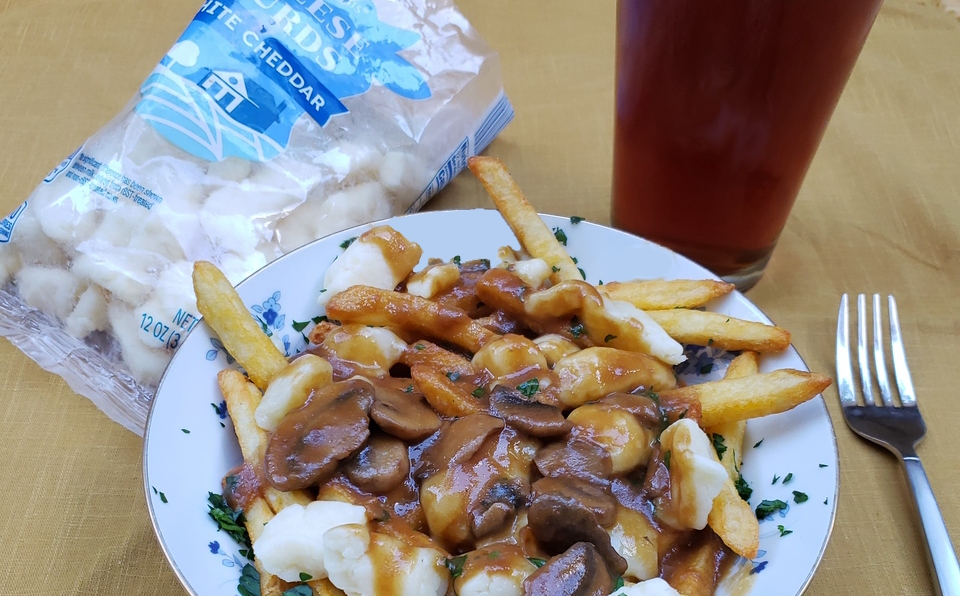Our recipe of the month is for French Canadian Poutine. A quintessential comfort food that hails from Quebec, Canada that can now be enjoyed throughout Canada and many other parts of the world. Who would have guessed French fries, gravy and some cheese curds could be so satisfying?

On a recent trip to Montreal, Canada, we got to enjoy many the culinary delights the region is known for. One of the tasty highlights of our visit was the opportunity to enjoy Poutine for the first time. It was a cold and snowy day, a perfect day to tuck into a large plate of crunchy fries, squeaky curds, and silky gravy. Considering the present cold snap we are experiencing here in San Diego, poutine will warm your soul and body.
The precise origins of poutine are hotly debated with several municipalities in Quebec laying claim to inventing the dish. Nevertheless, it is likely that the dish was invented in the 1950s, this is not a dish of great antiquity. The word "poutine" is thought to be derived from a Quebec slang term for "a mess" (more on this later!). There is also quite a variation in the way the word "poutine" is pronounced. French Canadians pronounce it "poo tsin", English speakers say "poo teen" and some folks attempt to approximate a French pronunciation and say "poo tin". For some time poutine had the reputation of being considered rather like mac and cheese, but the dish can now be found in many higher-end restaurants that tend to glorify it with additions such as duck comfit and pate foie gras. But it remains delicious in its more simple form.
The most unusual part of the dish is cheese curds, which are a soft cheese made with whole milk, rennet, and some version of lactic acid bacteria. Cheese curds are made by heating milk to 90-100°F, adding the "culture" and then the rennet. This results in the milk separating into curds and watery whey. The curds are wrapped and drained with cheesecloth. Curds for poutine are often "cheddared" in which sheets of curds are stacked and restacked repeatedly on each other which results in a firmer curd. And then the curds are cut into small morsels. The unique thing about cheese curds is that when they are fresh, they "squeak" when bitten into. It only takes a few hours for them to lose their squeak, so they must be made and then consumed in a quick sequence if this sensory aspect is desired. Pre-packaged cheese curds can be bought in both Ralph's and Aldis (which are substantially less expensive). The store-bought version lacks any hint of a squeak but its mild flavor is nevertheless quite delicious when combined with the fries and the gravy.
Archetypically, the gravy for poutine is beef gravy, but really any kind of gravy (chicken, pork, or vegetable) works. We made our gravy with beef stock and added our own "mirepoix" to enhance the flavor. Mirepoix is roasted onions, carrots, and celery that we blended to a smooth paste and added it to the gravy (note: I do this for our Thanksgiving turkey gravy too!). If you are in a rush, you can also use a gravy mix. We also added sautéed mushrooms for an added kick. The thickness of the gravy should be such that it will coat the back of a spoon. The typical ratio of making a roux is one part flour to one part butter (or oil).
Making homemade French fries is perhaps the best way to go. Ideally, the fries should be "double fried", first at a lower temperature (325°F) and then again at 350°F to make them extra crispy. If you have an air frying you can make excellent poutine with frozen French fries. Soaking the cut potatoes in cold water (see below) before they are fried will remove the exterior starch so that they brown better when frying. Drying the soaked potatoes with a cloth or paper towel is extremely important, meat and vegetables brown much better if they are as dry as possible before they are fried. Peanut oil can be used many times before it needs to be discarded. Just strain it with a strainer with 2 layers of cheesecloth back into the bottle (after is cooled to room temperature!). The more oil you use the better because you will have more temperature control. After you add the potatoes (particularly the first frying), the temperature of the oil will drop quite a bit (using more oil lessens this effect).
The final piece to the poutine puzzle is that when assembling the dish, the gravy should be hot enough to partially melt the curds.
Ingredients:
3 Russet potatoes
2 Cups of beef stock
4 Tablespoons of salted butter
4 Tablespoons of flour
1 cup or 1 package of cheese curds
Peanut oil or other high smoke point oil
Preparation:
The Potatoes-
Wash and then peel the sides of the potatoes (you can leave the skin on the ends for extra flavor).
Cut the potatoes into 1/2-inch strips
Soak the cut potatoes in cold water for at least an hour (preferably much longer).
Heat oil in a pot or oil fryer to 325°F. The amount of oil will depend on the amount of potatoes you are frying. If you are frying lots of potatoes, do them in batches.
Thoroughly dry the pre-soaked potato strips with a cloth or paper towel.
Fry the first batch (you don't want the potatoes to be too crowded) for 3 minutes or until the potatoes first show signs of browning. Remove the potatoes to a wire rack.
Heat the oil to 350°F and re-fry the potatoes until they achieve the level of browning you most enjoy. Remove the potatoes to a wire rack.
Salt the fries.
The Gravy-
Heat butter in a saucepan on medium.
After the butter is melted, add the flour and mix until the flour is fully incorporated.
Cook the "roux" for 3 minutes or until the mixture begins to brown. (Note, this will rid your gravy of the raw flour taste).
Mix in the beef stock slowly.
Simmer the gravy for 10 to 15 minutes. If the gravy is too thick, add water or additional stock. If it is too thin, simmer it longer.
*Cheese Curds-
We used pre-made curds, but you can visit: Cheese Curds Recipe to make your own!
Assembly, arrange fries on a plate, sprinkle with cheese curds, and top with gravy.
Casse-toi la couenne! (Quebec slang for "have a blast!" but literally means "break your neck!")
Recipe and Photos by T. Johnston-O'Neill









